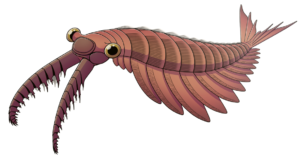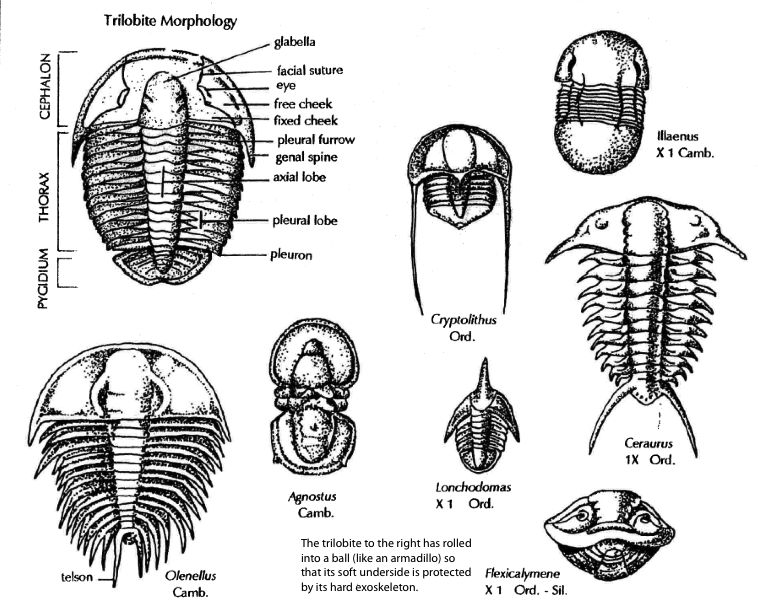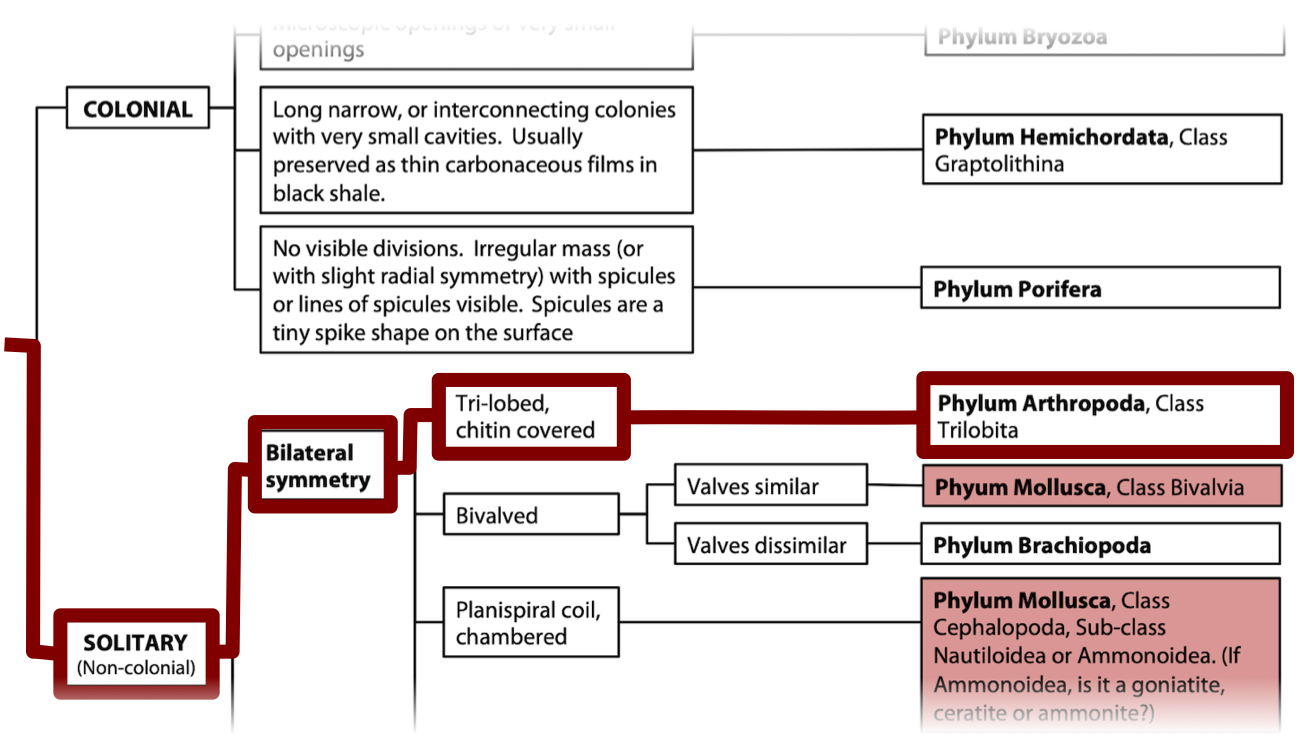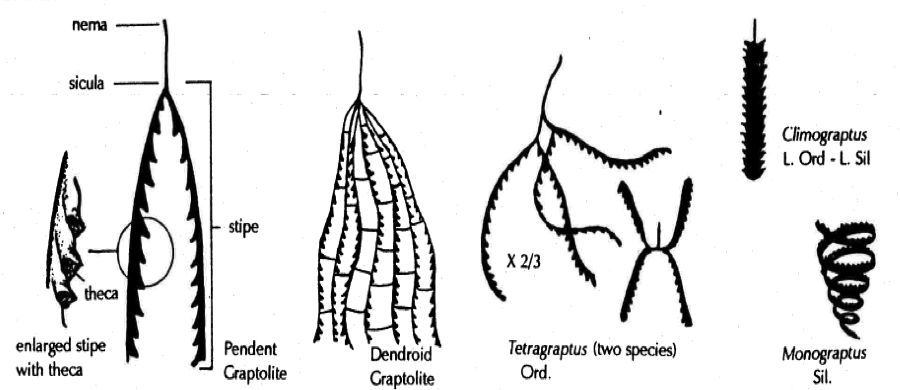Fossils of the Cambrian Period
The Cambrian Explosion (542 MY)
At the start of the Cambrian there was a sudden radiation of life into multiple forms. This interval of diversification lasted for about 10 million years (a relatively brief time, geologically speaking). This was known as the Cambrian Explosion.
There has been great debate over the classification of the strange-looking animals found from this period. Some paleontologists believe that these animals can all be placed into phyla found later in the Cambrian. Others believe that a wide diversity of body plans arose which can only be categorized using as many as 100 different phyla. In this latter theory, many of these phyla lasted only a brief time before going extinct due to competition with other organisms with more advantageous habits or body forms. This second alternative would suggest that many of the animals from the very early Cambrian have no living relatives at all.
One explanation for the sudden radiation of life at this time comes from the discovery of Hox genes. Hox genes are “architectural master genes” that determine the major components of organisms and how they are organized. For example, a mistake in a Hox gene in an insect might lead to an entire leg growing where an antenna should form. The Cambrian Explosion may have been helped by the development of Hox genes that resulted in more complex body plans than the preceding Ediacaran fauna.
The number of individual fossils preserved also increased tremendously, likely related to the increase in organisms with hard parts made of carbonates, chitin and cartilage. There were changes in atmospheric oxygen and in ocean chemistry that made the formation of these body materials more likely. It is also possible that new predators were making hard parts a distinct advantage to survival.
The Burgess Shale Collection
The most famous locale that preserves the life forms of the Cambrian Explosion is the Burgess Shale found in the Canadian Rockies in Yoho National Park. This shale layer preserves both the soft and hard parts of organisms in exquisite detail. Over 170 different species are preserved. It seems most likely that there was an algal reef forming in shallow water on which sediment accumulated. The Burgess Shale fauna lived in the quieter water downslope from this reef. On occasion, storms would cause the slope to collapse, and the Burgess fauna would be carried downslope and quickly buried in the deeper anoxic part of the marine basin. This scenario accounts for why so many soft bodied animals are preserved.
For Students Taking This Lab In Person
We are fortunate to have the last set of fossils made available from the national collection held by the Government of Canada. Samples from our collection are on display at the front of the room.
PLEASE DO NOT PICK UP ANY OF THESE FOSSILS OR TOUCH THEM IN ANY WAY.
Take some time to tour the collection. It is likely the only opportunity you will have in your lifetime to see these fossils up close. There are printed guides to our fossil collection at the front.
The Burgess Shale is famous for the “monsters” preserved there. These include Anomolocarus canadensis (Figure 6.9), which typically grew to 50 cm length and would swim through the ocean, occasionally grabbing and eating unsuspecting trilobites.

Another “monster” was a worm that burrowed and hid in the sediments, poking its mouth out to grab prey walking past. Fossilized remains of these organisms have been found with small mollusks (like a slug/snail) preserved in their guts.
Following the Cambrian Explosion, nearly all of the major phyla we see today had evolved. Only one that we will examine, Phylum Bryozoa, emerged later during the Ordovician Period. The Cambrian Period was dominated by a few fossils. We will look at one group—the trilobites—in this lab, and the rest in Lab 7.
Phylum Arthropoda, Class Trilobita (Cambrian to Permian, peak in Cambrian)
Where Do Trilobites Fit In?
Kingdom Animalia
Phylum Arthropoda – invertebrate animals with jointed legs and segmented bodies. Phylum Arthropoda may have arisen at the time of the Ediacaran fauna.
Class Crustacea -lobsters, crabs, barnacles (we will not cover these)
Class Trilobita – trilobites arose during the Cambrian
Class Insecta
Some of the best known and best preserved fossils from the Cambrian Period are the trilobites (Figure 6.10). These comprised up to half of the marine community at that time. They were part of Phylum Arthropoda, which includes modern insects, spiders, scorpions, lobsters and barnacles, and the extinct trilobites and eurypterids. Arthropods exist in all environments and use every form of locomotion. Arthropods are estimated to comprise over 80 percent of all known living animals, representing over a million species. We will only discuss a few in the next few labs. Arthropods are characterized by their jointed appendages, hence the name (anthron=joint + pous=foot).

A. Sample 121-31: Trilobite (Whole Individuals)
These samples can be picked up but please treat them with care.
a. Draw a sketch based on 121-31 that you can use as a trilobite study guide. Include any features you would need to remember in order to identify a trilobite in the future.
Flow Chart Decision Path for Trilobites

B. Sample 11: Trilobite Head and Eyes
This sample is very fragile. Please do not handle it or touch it.
Trilobites were scavengers who walked along the surface of the seafloor eating organic carbon (detritus) found in the sediments. For a trilobite on the sea floor, having light sensitive spots would help detect night and day for feeding safety, but may also have helped detect the shadow of a predator swimming overhead. Trilobite eyes became extremely sophisticated and capable of good vision.
Examine this trilobite head. The bumps on the eyes are each an individual lens. Many trilobite species had near-360 degree vision.
Question b
C. Samples L9 & L9A: Trilobite Tails
This sample is very fragile. Please do not handle it or touch it.
This rock preserves many tails of the same type of trilobite. There are occasional pieces of thorax plates, but the tail segments have stayed together in coherent pieces. Arthropod exoskeletons are made from chitin, which cannot expand at the animal grows. Thus, it must shed its exoskeleton and form a new one. Modern crabs and lobsters periodically molt like this. It is likely these discarded segments that are preserved in this fossil.
Question c
Phylum Hemichordata, Class Graptolithina (Middle Cambrian to Lower Pennsylvanian, peak in the Ordovician)

These fossils resemble heavy pencil marks due to their usual preservation by carbonization. Close up, one can see many cup-like features (theca, pl. thecae) along the axis of the “pencil mark”. Each of these used to house a tiny polyp animal likely similar to a coral animal. A graptolite may have been composed of one or many “branches”. In some forms, several “branches” were attached to a float, whereas in others the “branches” attached together. This life habit allowed multiple animals to live together in a free-floating colony. Each animal was a filter-feeder that swept food out of the water column.
Graptolites developed in the late Cambrian and like trilobites they are only found in Paleozoic fossils, having become extinct by the middle Carboniferous Period.
D. Sample 18: Graptolites in Brown Siltstone & Black Shale
These samples can be handled but please do not touch the surfaces where fossils are present.
The graptolites in brown siltstone were obtained from rocks of Ordovician age and contain a species known as Leptograptus flaccidus (you do not have to remember species names). The graptolites in black shale were collected from rocks formed during the Silurian Period.
Question d
E. Sample GRFLG-1: Graptolites
These samples can be handled but please do not touch the surfaces where fossils are present.
These graptolite fossils show more clearly the separation between individuals in the colonies. Make sure you can see these features.
Question e
F. Sample FJA1: Large Rock Sample With Graptolites
These samples can be handled but please do not touch the surfaces where fossils are present.
These graptolite fossils show more clearly the separation between individuals in the colonies. Make sure you can see these features.
f. What types of preservation occurred with the graptolites? Explain your reasoning.
g. Compare the different Sample 18 specimens with GRFLG-1, FJA1, and the GIGAmacro graptolites from Lab 5 (shown below). When you zoom in, you will observe the serrated or uneven edges of some these colonies. Draw an example colony showing these features which you can use as a study guide for Class Graptolithina.
